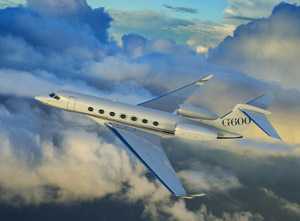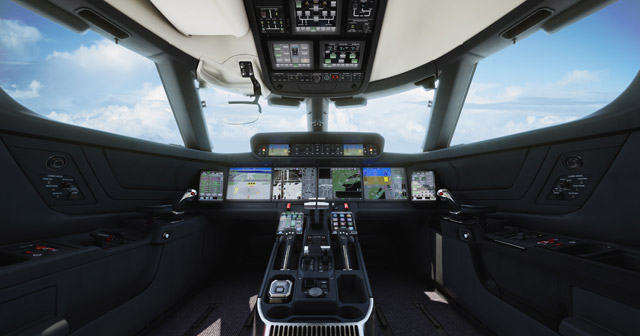Gulfstream Aerospace has just added two more long-range, wide-cabin airplanes to its line of business jets: the G500 and G600. In a huge event in the company’s new assembly building Y, 3,000 employees, suppliers, financial analysts, and media got the first look at the new airplanes. The airplanes, in the works since 2008, have been developed under strict, military-like secrecy—although rumors have abounded about a new Gulfstream in the works for years.

The G500—which made a surprise appearance by taxiing in front of the crowd—will be a Mach 0.90, 5,000-nautical-mile (at Mach 0.85), up to 18-passenger design. The G600, represented by a cabin and cockpit mockup, will also have a maximum speed of Mach 0.90, but a larger cabin and a maximum range of 6,200 nm (at Mach 0.85). At Mach 0.90, the G500 and G600 will have maximum ranges of 3,800 and 4,800 nm, respectively, Gulfstream says. Both are clean-sheet designs, the company says, although there’s no mistaking their resemblance to existing Gulfstreams.
These new airplanes mark a revolution in Gulfstream design, for several big reasons. First, both are powered by Pratt & Whitney Canada turbofans; traditionally, Gulfstream has used BMW-Rolls-Royce engines. The G500 will use Pratt & Whitney’s PW814GA engines of 15,144 pounds of thrust. The G600 will use PW815GA engines rated at 15,680 pounds of thrust. Of the G500, Gulfstream said that its engines will be 10 percent more fuel-efficient than the engines used in Gulfstream’s G450. Both engines have times between overhaul of 10,000 hours, or “about 20 years’ worth of flying,” according to a Gulfstream official, who added that no midlife inspections will be required. The engines should be certified by next month.

Specifications at a glance:
Gulfstream emphasized the fuel and time savings promised by these engines by stating that based on flying 218,500 nm per year, the G500 and G600 will save 52 hours of flight time over competing airplanes cruising at Mach 0.80. Also aiding fuel efficiency is the airplanes’ newly designed wings, which will be built by Gulfstream in the new building Y. Another new building, building Z, will be used to build and assemble fuselages and other components. With other Gulfstream designs, wing construction was done by contractors such as Vought Aircraft and Spirit AeroSystems. Buildings Y and Z, both 400,000 square feet in area, were built especially for G500 and G600 assembly.

The airplanes’ fly-by-wire cockpits feature Honeywell’s new Symmetry Flight Deck, which is based on Honeywell’s Epic platform. The Symmetry system features 10 touchscreen controllers, plus head-up displays (HUDs), the latest, third-generation enhanced vision systems (EVSs), and synthetic vision systems (SVSs) as standard equipment. Also noteworthy are the active control sidesticks (ACSs). Unlike other fly-by-wire control sticks, in which one sidestick is given control and the other is locked out, the ACSs are connected. When one sidestick is moved, the other also moves. This enables both pilots to be “on the same page, enhancing safety,” said Dan Nale, Gulfstreams’ senior vice-president of Engineering, Programs and Test. The ACS design partners were BAE Systems, ThalesRaytheon Systems, Parker Aerospace, and MOOG Inc.
The G500 cabin is set up to have three living areas, and the G600 will have four. The cabins will be 7 feet, 11 inches wide (which is seven inches wider than the G450’s cabin), and 6 feet, 4 inches high. The G600’s cabin length, at 45 feet, 2 inches, is four feet longer than the G500’s. Both airplanes can have multiple floorplans based on customer needs, both forward and aft lavatories, and forward or aft galleys. Cabin altitude at the airplanes’ maximum operating altitudes of 51,000 feet will be 4,850 feet, Gulfstream said.

The G500 will have a base price of $43.5 million; the G600, $54.5 million. Options and escalations will bump those prices up, Gulfstream said.
The G500 at the unveiling has yet to fly, although it did taxi into position in front of the audience. Five test articles of the G500 will be built, with another four to be built for the G600.
First flight of the G500 is set for 2015, with certification anticipated in 2017, and deliveries beginning in 2018. The G600’s first flight should come in 2017, with certification and first deliveries happening in 2018 and 2019, respectively.
At a ceremony, Gulfstream held signing ceremonies with its two launch customers for the G500. Qatar Airways signed a memorandum of understanding to buy 20 Gulfstreams, among them G500s and G650ERs. Fractional operator Flexjet LLC signed firm orders and options for 50 Gulfstreams, including the G500, the G450, and the G650.

High-speed cruise
Long-range cruise
Max operating Mach (Mmo)
Initial cruise altitude
Max cruise altitude
Max TO weight
Max Landing weight
Max zero fuel weight
Basic operating weight
Max payload
Max payload, full fuel
Max fuel
Cabin length
Cabin height
Cabin width
Cabin volume
Baggage volume
TO distance
Landing distance
Mach 0.90/516 kts
Mach 0.85/488 kts
Mach 0.925
41,000 ft
51,000 ft
76,850 lb
64,350 lb
52,100 lb
46,600 lb
5,500 lb
800 lb
28,850 lb
41 ft 6 in
6 ft 4 in
7 ft 11 in
1,715 cu ft
175 cu ft
5,200 ft
3,100 ft
Mach 0.90/516 kts
Mach 0.85/488 kts
Mach 0.925
41,000 ft
51,000 ft
91,600 lb
76,800 lb
57,440 lb
51,440 lb
6,000 lb
1,800 lb
38,760 lb
45 ft 2 in
6 ft 4 in
7 ft 11 in
1,884 cu ft
175 cu ft
5,700 ft
3,100 ft
G500
G600



